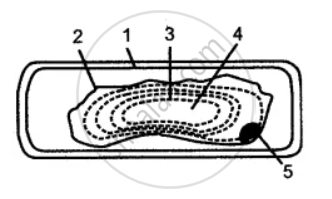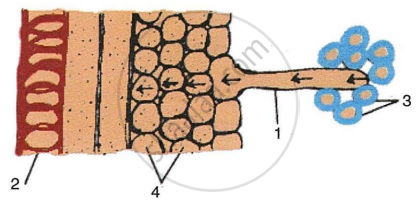Advertisements
Advertisements
प्रश्न
The below diagram represents a plant cell after being placed in a strong sugar solution. Guidelines 1 to 5 indicate the following:
1. Cell wall
2. Plasma membrane.
3. Protoplasm
4. Large vacuole
5. Nucleus
Study the diagram and answer the questions that follow :
(i) What is the state of the cell shown in the diagram?
(ii) Name the structure which acts as a selectively permeable membrane.
(iii) If the cell had been placed in distilled water instead of a strong sugar solution which features: would not have been present?
(iv) If the cell in the diagram possessed chloroplasts where would these be present?
(v) Name any one feature of this plant cell which is not present in animal cells.
उत्तर
(i) Flaccid.
(ii) Plasma membrane.
(iii) If the cell had been placed in distilled water it remains in a fully distended condition. Its plasma membrane remains in close contact with the cell wall and presses against it.
(iv) Chloroplast will be present in the protoplasm outside the vacuole.
(v) Cell wall.
APPEARS IN
संबंधित प्रश्न
A plant cell may burst when :
Give the equivalent terms for the following:
Loss of water through a cut stem.
What is the difference between ‘flaccid’ and ‘turgid’? Give one example of flaccid condition in plants.
Give suitable biological reasons for the following statement:
Root hairs become flaccid and droop when excess fertilizers are added to the moist soil around them.
Differentiate between the following:
Plasmolysis and Deplasmolysis.
Fill in the Blank
Wilting and drooping of leaves is due to loss of ________.
The hydrostatic pressure of the cell sap on the cell wall is called ______.
Addition of salt to pickles is a method of killing the bacteria by ______.
The figure given below is a diagrammatic representation of a part of the cross-section of the root in the root hair zone. Study the same and then answer the questions that follow:

- The parts labelled as 1, 2, 3 and 4 are:
- Root hair, Xylem vessel, Soil particles, Cortex respectively.
- Xylem vessel, Soil particles, Root hair, Cortex respectively.
- Root hair, Xylem vessel, Cortex, Soil particles respectively.
- Cortex, Soil particles, Xylem vessel, Root hair respectively.
- The process that enables the passage of water from soil into the root hair is:
- Diffusion
- Active transport
- Osmosis
- Passive absorption
- The kind of force which exists between a liquid and any surface is called as:
- Cohesive force
- Adhesive force
- Capillarity
- Suction force
- The kind of force between the same kind of liquid molecules is:
- Capillary force
- Transpirational pull
- Adhesive force
- Cohesive force
- Sometimes exudation of water occurs from the margin of the leaves in the early morning or night. It is termed as:
- Transpiration
- Guttation
- Bleeding
- Osmosis
